Discussion about UTSA and The University of Texas Health Science Center at San Antonio coming together under one metaphorical roof had persisted in some fashion for decades. But when the UT System Board of Regents and leaders at both institutions started deeply thinking about the synergies between the two universities, a captivating vision materialized — and those passing “what-ifs” suddenly gave way to exciting, engaging conversations.
“Whether you’re improving lives through medical intervention, healthcare and public health or you’re improving lives through educational attainment and upward social mobility, they both produce an outcome of making lives better,” President Taylor Eighmy explains. “We had this ‘a-ha’ moment when we realized the core missions of each of the institutions were actually identical in spirit: in terms of why we are here, why we serve and who we serve.”
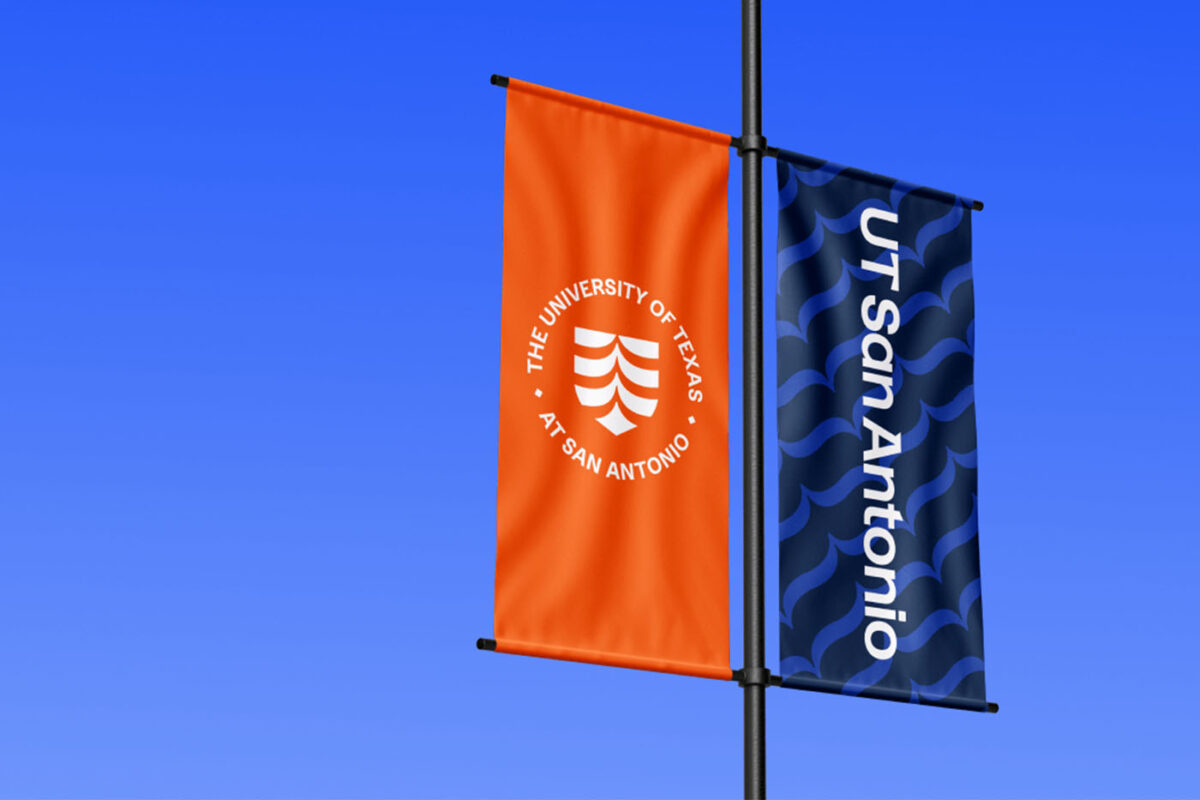
That a-ha moment was the genesis for a monumental announcement. In August 2024, the Board of Regents unveiled an ambitious and visionary plan to merge UTSA and UT Health San Antonio to establish one premier public university known as UT San Antonio. On Sept. 1, 2025, the two institutions, after years of speculation, finally became one university fiercely dedicated to making lives better.
The teams of Sombrilla and Mission magazines sat down with Eighmy, president of UT San Antonio, and Francisco Cigarroa, the university’s senior executive vice president of health affairs and health system, to discuss the timing and importance of this historic integration in addition to the positive impacts it will have on San Antonio, the state of Texas and the national research landscape.

Why now is the right time
Unifying the two institutions will elevate both to new levels
The UT System Board of Regents considered studies on merging UTSA and UT Health San Antonio twice before, in 2002 and 2010. Cigarroa remembers, in particular, that State Sen. Leticia Van de Putte was determined to make it happen in 2010 because she saw the potential impact of the two institutions unifying their resources. She felt that an integrated university in San Antonio would be well-positioned to eventually become a top-tier research university and be eligible for additional funds to enhance research from the Texas Legislature.
In the same context, U.S. Sen. Kay Bailey Hutchison would often ask regents and chancellors how Texas could establish an additional university designated by the Association of American Univerisities (AAU), which is the highest designation of a university in the U.S. and Canada. These universities are the very best in education, research, innovation and discovery. “Senator Hutchison would often state that California has nine (AAU institutions), New York has seven, but our great state of Texas only has three,” recalls Cigarroa, who was serving as chancellor of the UT System at the time. “She actually challenged us to figure out a way of creating a fourth AAU university.”
The last study assessing the feasibility of a merger, led by former UT Austin and UTSA President Peter Flawn, concluded that the timing was not quite right for a merger in 2010, but that it ought to be strongly considered in the future. In 2024, the UT System Board of Regents felt the time was perfect to pursue an integration between the two San Antonio institutions. Such a merger would elevate the city to the nation’s forefront in education, discovery, biomedical science, healthcare and digital technology. It would also result in the creation of one of the nation’s top public universities with a focus on excellence and access with the biggest beneficiaries being the students of the San Antonio region.
The UT System Board of Regents is well known to be visionary and bold, and the decision to move forward with the merger of UTSA and UT Health San Antonio is aligned with this spirit. “It took true leadership from our Board of Regents to go in on this because of the size and scale of it, but I think both institutions had to be ready for this,” Eighmy explains. “Both were on steeply positive trajectories. With all of the progress that’s happened at UT Health San Antonio over the last 15 years under Dr. William Henrich and the progress at UTSA over the last decade, the time was right.”
This integration not only establishes UT San Antonio as a premier institution but also puts the newly-integrated university on the path to joining The University of Texas at Austin, Texas A&M University and Rice University as the Lone Star State’s fourth AAU member.
“Taylor Eighmy and I understand that it’s a huge responsibility, but it’s also a once-in-a-lifetime opportunity to merge these two very outstanding universities into one,” Cigarroa says. “That’s a special calling.”
“And we’re going to go big on this,” Eighmy adds.
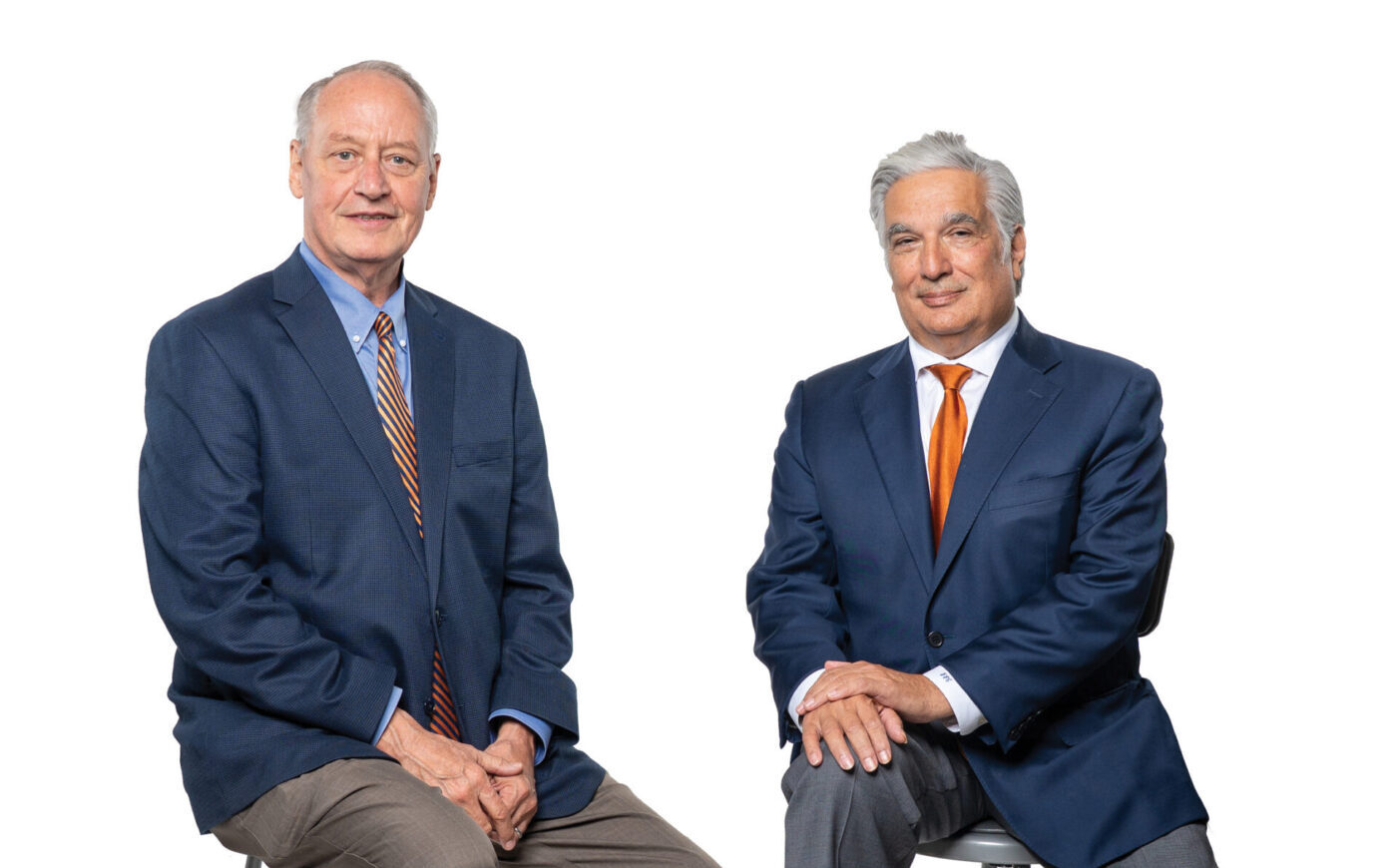
WATCH: Taylor Eighmy and Francisco Cigarroa sit down to discuss the transformative impact of the merger.
‘Big impact’: UT San Antonio's emerging status
From the economy to research, the new UT San Antonio will be a major player in the state
On Sept. 1, UT San Antonio became one prodigious university boasting more than 40,000 students and 17,000 employees. It became a consolidated institution with annual research expenditures of about $486 million and an endowment of approximately $1.3 billion that now generates $7 billion per year in economic impact. UT San Antonio also surpassed many great institutions to firmly establish itself as the third-largest research university in Texas, trailing only Texas A&M and UT Austin.
To say it’s one of the greatest mergers in the history of American higher education wouldn’t be overstating its significance, Eighmy explains.
“In my conversations with presidents around the country who are keenly interested in what we’re creating here, they’re all in awe of our potential. They also realize that our shared impact will be so profound when we are formally brought together,” he says. “Now we have the gravitas of being an institution that can and will have a really big impact on solving society’s grandest challenges.”
Beyond the university’s soaring status, Eighmy says he’s especially excited for current and future UT San Antonio students. They can feel assured knowing that they’re getting a top-tier education, he says, with more hands-on learning experiences, collaborative capacity and professional opportunities in front of them than ever before.
Most importantly, the San Antonio region — one of the fastest-growing and developing areas in the U.S. — now has the kind of premier public university that it has long deserved.
“I do believe that we are going to be one of the great universities of the 21st century,” Cigarroa says. The opportunity to create this university that’s going to significantly excel and catalyze education, research, healthcare and translational science is profoundly large.”
“We became a world-class university on day one of the merger,” Eighmy says. “In spite of the headwinds that higher education is presently facing, it is really important to emphasize that there is so much opportunity in the state of Texas. If you give us 10 years, we are going to go to the moon.”
LEVELING UP IN THE LONE STAR STATE
UT San Antonio is now the third-largest public research university in Texas. The combined total research expenditures of UTSA and UT Health San Antonio in 2024 have established the university’s impressive new standing among the state’s comprehensive doctoral-granting universities.
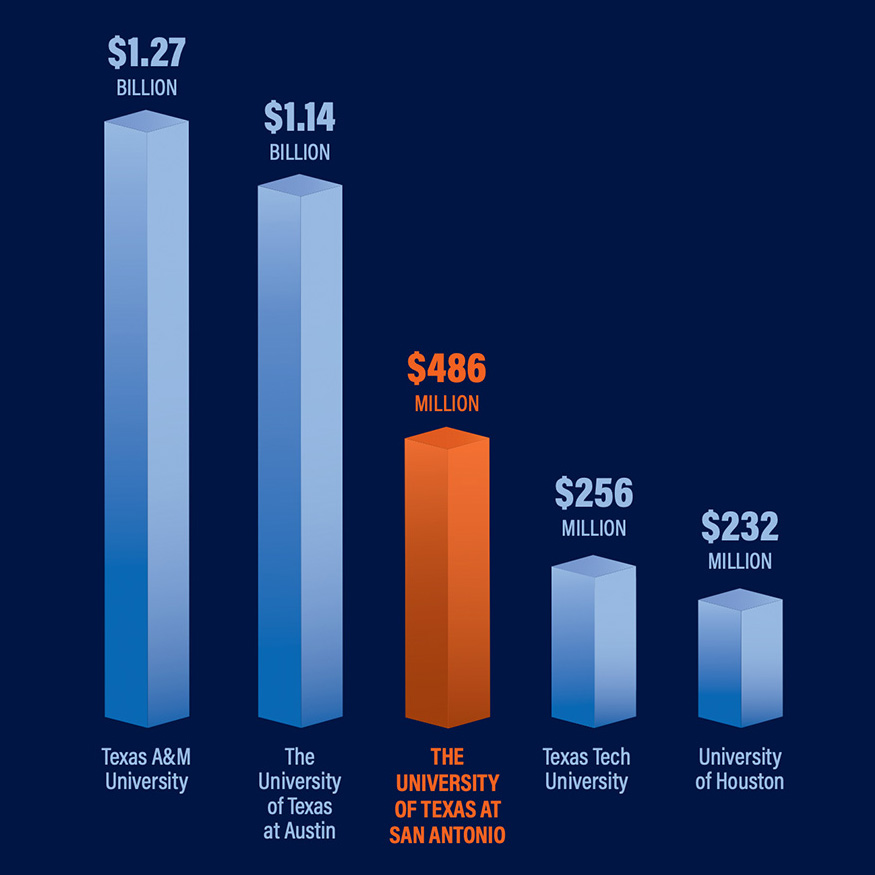
Figures based on the most recent annual total research expenditures made available in each university’s annual reports. This ranking excludes institutions that are solely academic medical centers or health science centers.
A new national research powerhouse
The new university plants its flag as a leading hub for collaborative research and transdisciplinary discovery
The merger of UT Health San Antonio and UTSA united two R1-designated institutions, recognized for their “very high research activity” by the 2025 Carnegie Classifications. UT Health San Antonio was already a major contributor to the city’s $44.1 billion health care and biosciences industry, and translated to medications, treatments and therapies that changed the lives of people in San Antonio and around the globe. Meanwhile, UTSA had announced a new plan to hire clusters of faculty scholars to expand its core capabilities and expertise in key areas such as brain health, microbiome, artificial intelligence and materials science. Now unified as one, UT San Antonio will be the home to six federally funded research and development centers. This university will provide the environment for Nobel Laureate levels of discovery and other remarkable successes by the faculty, staff and students.
By pooling these resources, the new university will not only reinforce San Antonio’s position as a launchpad for innovation but will also elevate the region’s reputation of research excellence and scientific influence in national conversations.
“The very best institutions — the University of Washington, the University of Michigan, the University of California, Los Angeles, UC San Diego, UNC-Chapel Hill — all have incredibly large academic medical centers and very large academic institution components with research happening in both places,” Eighmy explains. “The model of bringing our two institutions together really matches that construct.”
From the impacts of artificial intelligence on medicine and cybersecurity on health services to collaborative advancements in biomedical engineering and biochemistry, the merger will lead to innovative breakthroughs in translational science and improved health outcomes.
“We are creating a new world-class university here that has even more of the ingredients of collaborative research and transdisciplinary discovery between medicine and the basic sciences than any other public institution in Texas,” Eighmy says. “You couldn’t ask for any better ingredients.”
The newly unified UT San Antonio will also be much better positioned to yield more funding for vital research projects from major foundations, private sector state agencies and federal agencies like the National Institutes of Health and the National Science Foundation.
“Our research funding opportunities have been catalyzed. Having new synergies between different disciplines and bringing different faculty together is going to allow us to write the very best, most competitive grants and earn our fair share of funding,” Cigarroa says. “It’s a competitive world, but we’re all Roadrunners now and we’re going to win those races.”
Imagine the possibilities
The new UT San Antonio will bring colleges and schools from both institutions together — creating exciting new opportunities for collaboration and discovery in research, academics and community impact.
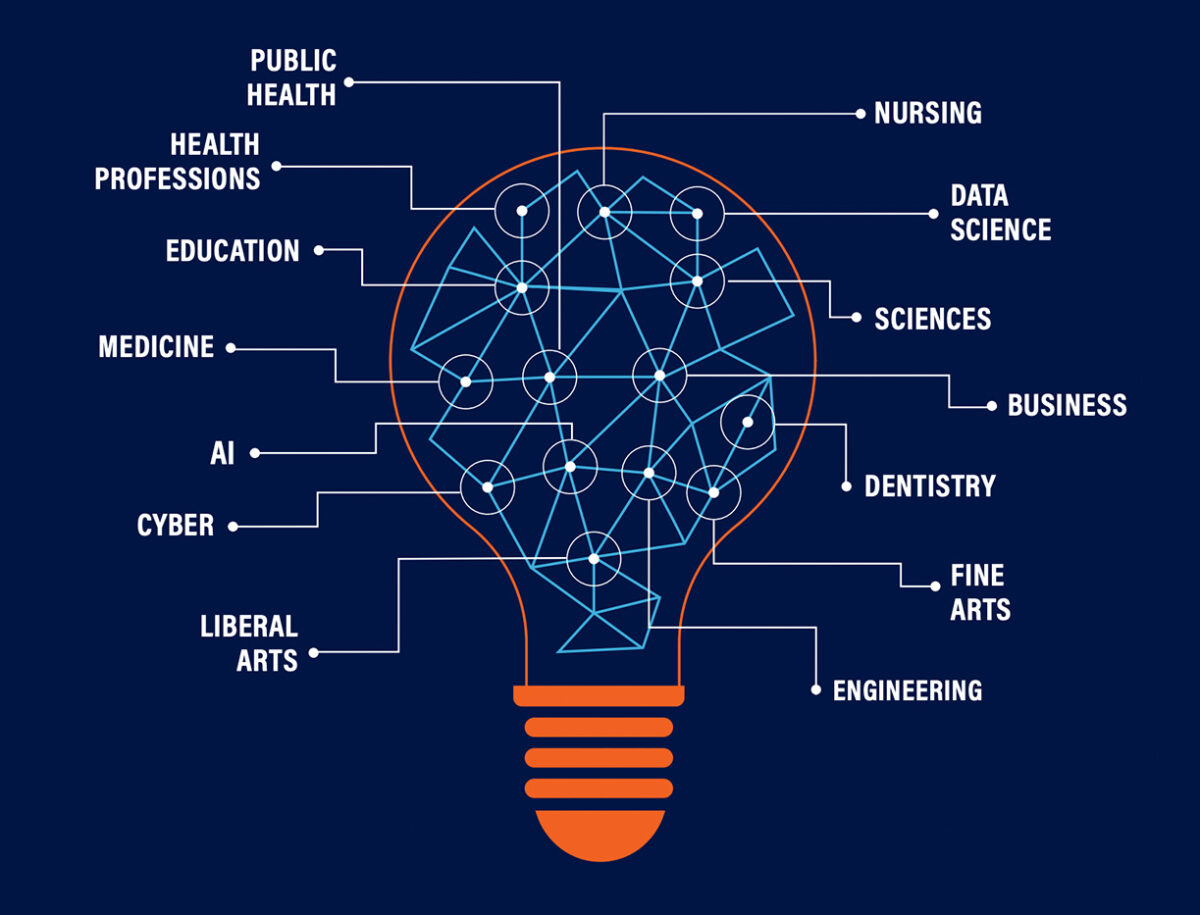
Excellence attracts excellence
UT San Antonio will create new career pathways and attract talented faculty and researchers to the city
Bringing UTSA and UT Health San Antonio under one banner will not only lead to greater innovations in research and translational science. The resources available at UT San Antonio will also draw more of the world’s most talented educators and researchers across hundreds of disciplines to the city.
“UT San Antonio is going to enrich the culture that makes San Antonio — and the entire region that we live in — not only the best place to raise a family, but also the best place to study and the best place to work,” Cigarroa says.
At a highly touted academic research and academic health institution like UT San Antonio, faculty, doctoral and postdoctoral researchers will have expanded opportunities to see their scientific work translated into real-world applications. This could potentially lead to more prominent international research collaborations and other partnerships or local initiatives that could positively benefit the region, Eighmy explains.
“Excellence attracts excellence. Excellence attracts opportunity. Excellence attracts resources. Excellence creates impact. Excellence drives the world,” Eighmy says. “And what we’re intending to do is promote this evidence of excellence that we already have at each respective institution to build a strong foundation for this new world-class university we’re creating.”
The newly integrated UT San Antonio is now more appealing to promising undergraduate students as well. In addition to learning from accomplished faculty, they will have more pathways available in the future to unique master’s and doctoral degrees that will offer them advanced and specialized training not offered by many other universities in the United States.
One dual degree program at UT San Antonio that melds the expertise of the two previously separate universities is the MD/MSAI, the only program of its kind in the nation. Students in this program earn a Master of Science in Artificial Intelligence and Doctor of Medicine to enter the workforce as skilled physicians who can uniquely lead in the practical use of AI to improve diagnostic and treatment outcomes. Cigarroa envisions many more of these kinds of cutting-edge dual degrees springing up at UT San Antonio in the near future.
“We’re going to be able to foster new dual degree programs that we’ve never had before. When those synergies of expertise come together, that allows us to innovate. And that’s going to be available now to undergraduate students, to graduate students, to faculty and to scientists across the spectrum of this new university,” Cigarroa explains. “This really is one of the greatest decisions that the UT System Board of Regents has ever undertaken.”
Where excellence meets access
UT San Antonio is one of only 21 higher education institutions to earn both the R1 and Opportunity Colleges and Universities designations from Carnegie. These designations point to the nation’s greatest universities with a dual focus on research excellence and student success. In other words, these universities are creating successful paths to competitive earnings for students in their communities and giving them the opportunity to learn from respected faculty and innovative researchers.
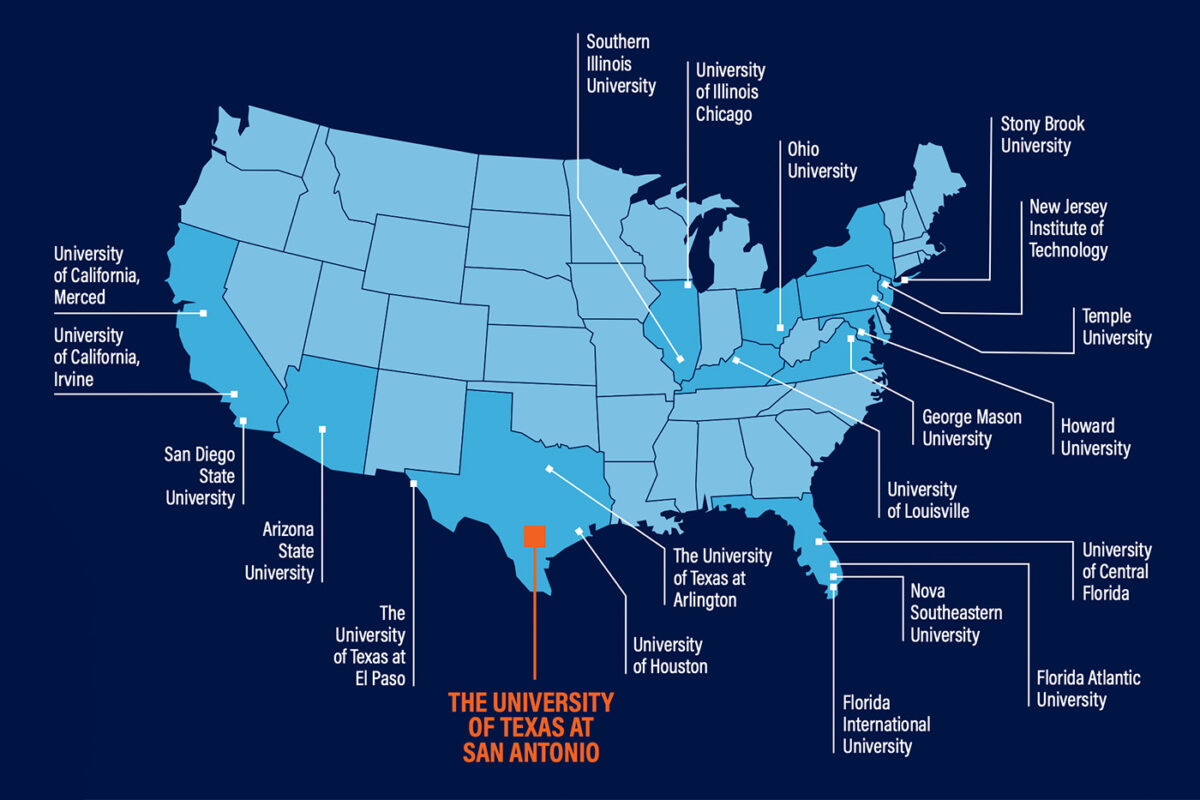
A beacon for opportunity and access
The university strives — at a prolific level — to make college affordable and put its graduates on a path to success
Eighmy and Cigarroa share a fundamental belief that even though UT San Antonio’s profile is rising around the world, its collective mission to drive upward social mobility in South Texas will remain a top priority. In other words, “access” will be just as important as “excellence.”
“This university will give any individual the opportunity to fulfill their aspirations,” Cigarroa says.
Months before the two institutions merged, UTSA earned the brand-new designation as an Opportunity College and University by the Carnegie Classifications, which recognized approximately 16% of universities in the U.S. as models for fostering student success and promoting upward social mobility. The institutions that earned this designation were lauded in large part for “higher access” and “higher earnings.” Simply put, they are expanding paths to bachelor’s and graduate degrees for their communities, and their students earn higher average incomes than their peers after graduation.
Making college more affordable had been a consistent goal for several years for UTSA, where many initiatives were put in place to ensure that fewer financial hurdles stand in the way of talented students who want to pursue a high-quality college education. By the spring of 2025, UTSA graduates were leaving school with $5,000 less in student loan debt than the national average and $4,000 less than the state average. In fact, 39% of students graduate with no loan debt whatsoever.
Roadrunners have also been seeing profound returns on their investment. The average salary of UTSA students who graduated in the last three years is $65,000, well above the average salaries in the San Antonio metro area and Texas at large. U.S. News & World Report, Forbes and The Wall Street Journal all recognized UTSA as a top performer in advancing social mobility before the institution merged with UT Health San Antonio. With expanded pathways to advanced medical, dental and other health professional degrees, UT San Antonio will now be among the nation’s most prolific providers of access to a life-transforming education.
Eighmy is quick to point out that UT San Antonio is one of only 21 universities in the nation — and one of just four in Texas — to hold both the R1 research and Opportunity Colleges designations from Carnegie. This is an important development for San Antonio.
“We are going to keenly focus on expanded access and opportunities to elevate the educational attainment of our community here in San Antonio, across the region and all throughout Texas,” Eighmy says.
“We play an absolutely critical role in driving the development and growth of our city and our region.”
Taylor Eighmy, President

Shaping San Antonio’s future
Through educational attainment and workforce development, UT San Antonio aims to lift the Alamo City
In 2024, the greater:SATX Regional Economic Partnership released a report exploring the workforce outlook for San Antonio. The report found that the region’s educational attainment rate — the percentage of individuals with a two-year associate’s degree or higher — trailed every competitive metro area, from Seattle, Phoenix and Denver out west to Nashville, Charlotte and Washington D.C. out east.
This hasn’t just been a detriment to individuals and their families in San Antonio but has also stymied development in the region. Several notable employers have passed over San Antonio when seeking new locations for corporate headquarters or large office operations in the past because they felt the region didn’t have a college-educated workforce large enough to feasibly support such expansions.
“Fortune 500 companies and other large employers want to know: Do we have the university educational systems? Do we have the community college districts? Do we have advanced universities that are tier one in research to create the pipeline that’s required now for the future of work?” Cigarroa asks.
The collective efforts of institutions like UTSA and Alamo Colleges, which launched the Bold Promise and Alamo Promise tuition programs in 2019, have already helped turn the tide. San Antonio’s educational attainment rate shot from 35.6% in 2018 to 41.9% in 2022. Now, the new UT San Antonio is poised to provide a sea change for economic and workforce development in the San Antonio region.
As an example, Cigarroa explains that UTSA’s strengths in AI, computer science and engineering, and UT Health San Antonio’s strengths in biomedical education, research and clinical care are highly complementary. The newly consolidated university will produce more skilled graduates in those coveted fields and more collaborative research where those fields overlap. As philosophy, art, politics, economics and scientific innovation increasingly intersect in society, UT San Antonio will also create more cross-disciplinary opportunities between the humanities and sciences. In turn, this will entice more partners and employers looking to stake their claims in the Alamo City.
“In every metric that I see, this integration is going to develop new innovations that are translated to market,” Cigarroa says. “It’s going to spin out new companies, as it already has in artificial intelligence. It’s going to lead to drug development, which will bring pharma into San Antonio. It will produce engineers that could help our city, our community and our state with transportation needs. It’s a very powerful investment in the pipeline of our future workforce.”
The merger also gives UT San Antonio the opportunity to cast a wider net in the region and to offer its united expertise and resources to any community partner who could benefit from them. Eighmy has often been quoted as saying that “great universities need great cities, and great cities need great universities.” Positioning a world-class university to grow alongside a booming region isn’t just something that’s necessary; it’s paramount.
“If we don’t lean in at the local level — if we aren’t working with our government, civic organizations, our business community or our fellow education and healthcare providers — we are losing the opportunity to maximize this impact,” Eighmy says. “If you think about the real significance of the merger’s impact, it has to go beyond the direct benefit to our institutional community members, as important as that is. We play an absolutely critical role in driving the development and growth of our city and our region. We have a moral responsibility to lead that effort.”



No comment yet, add your voice below!